
Order Confirmation Emails: Pro Tips And Examples [2025]
Consumers shopping online crave reassurance the moment they hit “Place Order.” A simple yet powerful way to ease their minds? Send proof straight to their inbox. The so-called order confirmation emails.
When crafted smartly, they can do more than confirm a purchase; they can build trust, boost engagement, and even drive conversions. Let’s explore how to set them up effectively and turn a simple transactional message into a strategic asset for your eCommerce business.
What Is an Order Confirmation Email?
Order confirmation emails are transactional messages that inform buyers that their order is complete. These automated follow-ups are triggered right after an order is placed and typically include important information such as order number, contact information, tracking link, and delivery address.
Most email marketing platforms like Moosend or Mailchimp let you set up these email types easily. Since they usually receive high open rates, marketers often combine promotions, such as complementary products or personalized recommendations to keep the momentum going.
Why Are Order Confirmation Emails Important for Businesses?
Here are some of the main benefits of delivering order confirmation emails to your buyers:
Strengthen your brand’s credibility
These confirmation email types do more than just inform; they build trust. Include important order details to reassure customers that your website is secure and their transaction was successful. This transparency helps establish your brand as reliable and professional. Finally, your sender name should look trustworthy to ensure open rates.
Inform customers about next steps
Beyond making your customers feel secure, order confirmation emails help them set the right expectations for what comes next. For example, include the estimated delivery date or social proof to reinforce the value of your products or services. You can also schedule a second follow-up with shipping information to give them a heads-up, including a tracking link.
Boost open rates
Did you know that order confirmation or receipt emails receive an open rate reaching up to 70%? The high engagement gives an excellent opportunity to tell your customers more about your brand, including content that can lead to more conversions down the line, from helpful resources like FAQs to product recommendations.
Serve promotional purposes
Order confirmation emails offer a space for subtle promotion. Consider adding up-sell or cross-sell suggestions, but keep the tone helpful, not pushy. This purchase email can also become a starting point for an automated workflow, especially for first-time customers. Guide them toward loyalty programs, onboarding content, or future purchases.
Order Confirmation Email Best Practices
Are you ready to craft your first order confirmation email or improve this marketing strategy? Here are some helpful tips:
1. Schedule the email straight after the purchase
To create a top-notch customer experience, schedule these emails within a few minutes after the order placement. This will reassure your customers that everything is under control and allow them to double-check their information, such as the billing address.
It also gives them a chance to review important details while the transaction is still fresh in their minds, like the shipping method or payment information. If anything needs correcting, they can act fast, which helps reduce support requests and builds trust in your process.
2. Add all essential information
Let’s see some of the key information businesses add to these transactional emails:
- Order summary/number
- Order date
- Tracking number
- Paid amount
- Payment method
- Customer contact information
- Shipping method/address
- Expected delivery date
It’s up to you to decide what’s best to add, but don’t overlook the power of customer support details. Many online stores add a support email address, live chat link, or phone number in case something goes wrong.
If there’s a hiccup with the order or shipping, customers know exactly where to turn. That kind of accessibility helps resolve issues quickly and ensures that customer satisfaction bounces back fast, even when minor setbacks occur.
Let’s have a look at this email by Affinity:

What would you keep or change? Consider your customers’ expectations and pain points to craft a valuable and relevant order confirmation email.
3. Write a distinct subject line
To increase open rates, it’s essential to craft subject lines that are both clear and engaging. A well-written subject line should hint at the content of the email. Below, we’ve listed some email subject line examples to get inspired:
- Your [Company name] order receipt
- Alexandra, your order with the number [#] has been successfully placed
- Your [Company name] order is confirmed
- Thank you for your order [#number]
- Hooray! Your order with [Company name] has been placed
You’ll notice a few patterns here: Including the company name and order number helps customers recognize the purpose of the email. Adding a cheerful tone will prompt them to open it with more excitement and read it through.
4. Display your brand
Every email is a new opportunity to show your brand to the world and leave a lasting impression. Order confirmation emails are no exception. Most email marketing platforms offer order confirmation or other ready-made email templates you can easily adjust to build a beautiful campaign.
Check out Moosend’s order confirmation email template:
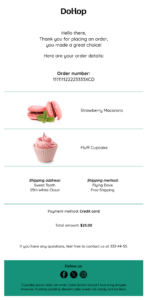
But it’s not just about email design. Make sure your brand voice shines through in the copy and keep your tone consistent across all communication channels. This consistency helps customers recognize and remember you, making them more likely to return if they connect with your products, services, or overall vision.
5. Combine with promotional initiatives
Order confirmation emails are not just meant to be informative. You can benefit from their popularity among subscribers and motivate them to take an extra step.
For example, include a call-to-action button that redirects them to your eCommerce site to explore related or recommended products. Or invite them to join your referral program. It’s a smart way to reward loyalty and turn happy customers into brand advocates.
But remember, the order details should always remain at the top of the email. That’s the core reason customers open it, so keep it in front and center.
6. Leverage personalization
Personalized marketing can work wonders for your brand. Beyond using the customer’s name in the subject line, you can take it a step further by using email list segmentation to tailor your message even more.
For example, segment your audience based on previous purchase history to deliver content that feels relevant and timely. You might want to introduce your customer loyalty program to new customers and your referral program with returning ones who’ve already shown interest in your brand.
7. Set complementary follow-ups
The post-purchase phase is great for nurturing customer relationships. With the right follow-up emails, you can stay top of mind and continue delivering value while the experience is still fresh. For instance, you can send receipts, shipping updates, or even cross-selling email campaigns with complementary products or services.
Use marketing automation software to build these sequences, but be intentional with your timing. Avoid overwhelming your customers with too many emails right after the purchase. It can feel pushy and may even land you in the spam folder.
8. Combine with SMS
Many eCommerce store owners combine email with SMS notifications for maximum reach. Platforms like Shopify even offer built-in features to support this dual approach.
If this sounds like something you’d like to try, make sure to get your customers’ consent first. This way, you can send timely updates via SMS, such as order confirmations, shipping alerts, or delivery reminders, ensuring your message gets seen even when inboxes are crowded.
7 Best Order Confirmation Email Examples & Why They Work
The theory is good, but we guess you’d love some great examples to inspire you before you plan your automation. Here you go!
1. Roark
Subject Line: Order #65005 confirmed
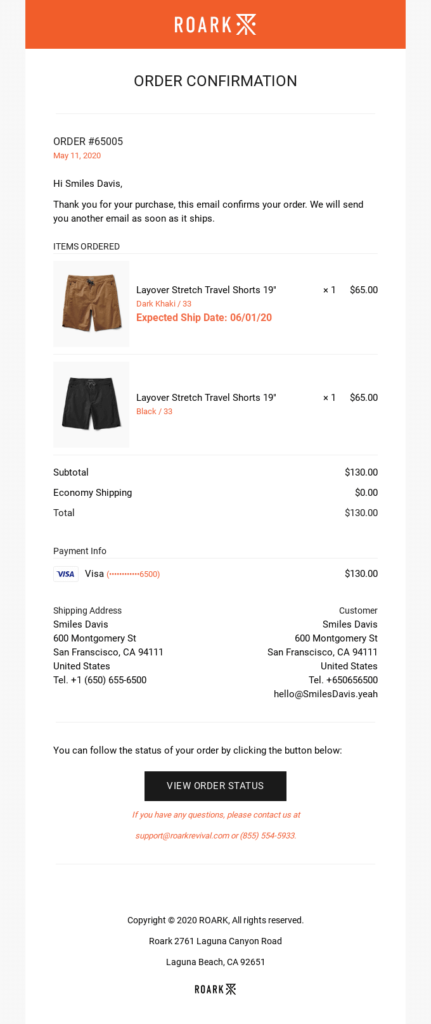
Let’s start with this excellent order confirmational email example from Roark, a men’s clothing brand. Even though it doesn’t have promotional elements to boost conversions, it stands out for its transparency and trust-building approach.
Why it works:
- The subject line reveals what this email is about reassuring customers that their order is confirmed.
- Customers can see the purchased products, including pricing and payment method information.
- They added a link with the order status and contact details in case someone wants to reach out.
2. Allbirds
Subject Line: Your Feet Say Thank You
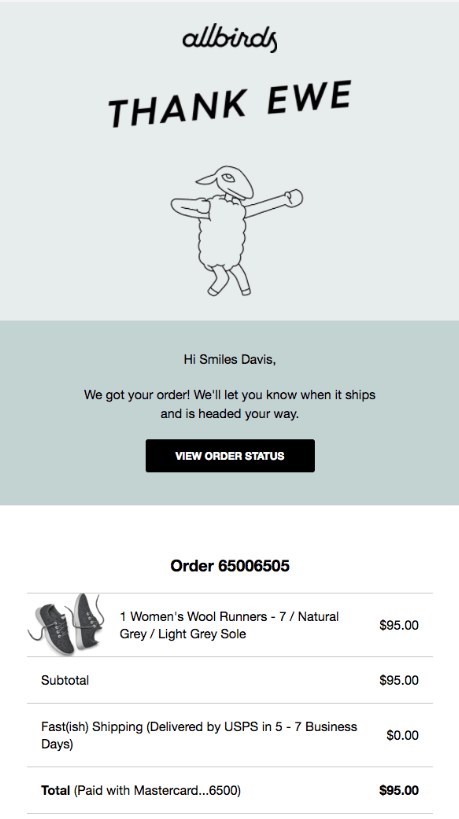
If you’re looking to make the most of your confirmation emails by consistently showcasing your brand voice and values, take a cue from Allbirds.
Why it works:
- It kicks off with a creative and humorous subject line, which is hard to ignore.
- The email includes a sustainability note, reinforcing Allbirds’ mission and reassuring customers that their purchase supports eco-friendly practices.
- In the email footer, they’ve added social media links, encouraging happy customers to stay connected and follow the brand across channels.
3. Redbubble
Subject Line: Here’s your order confirmation.

Redbubble took a more detailed approach with their order confirmation email. It’s a great strategy, especially for first-time buyers looking to get familiar with the brand.
Why it works:
- The email opens with the order status and estimated delivery rate, setting clear expectations at the beginning of this campaign.
- Just below the essential product details, readers can find company values, followed by an FAQ section to address common concerns.
- They wrapped up with a kind reminder to download the app and some useful links to engage customers further.
4. Patagonia
Subject line: Confirmation of Your Order [Number]

Patagonia crafted a comprehensive order confirmation email that not only informs customers but also reassures them that everything is under control.
Why it works:
- The email opens with a thank-you note in the title, immediately expressing appreciation and setting a warm, customer-first tone.
- They encouraged customers to monitor their order status, especially in case of unexpected delays to manage expectations.
- The eco-friendly notes highlight the brand’s values to resonate with like-minded customers.
5. Amazon
Subject Line: Your Amazon UK order of “The Midnight Library” and 2 more item(s)
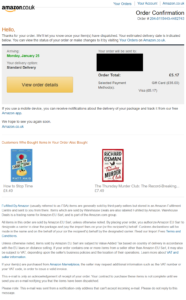
Now, let’s see an order confirmation email from the eCommerce giant Amazon.
Why it works:
- The email includes a detailed breakdown of terms and conditions to address any potential customer concerns upfront.
- It features related product recommendations based on what other customers have purchased to encourage additional browsing or buying.
- A bold yellow CTA button makes it easy for customers to check their order status with just one click.
6. Burst
Subject line: [Customer name], Your Order #650050 for BURST has been placed

Here’s a personalized order confirmation email full of relevant information from Burst.
Why it works:
- The personalized subject line instantly grabs the recipient’s attention, adding an unique and engaging tone.
- They informed readers that they’ll reach out again with a shipping confirmation email, another important automated email that keeps customers informed.
- The social proof in the end in the form of recognizable brand logos reassures customers that they made a great choice.
7. Uber
Subject line: [Personal] Your Saturday morning order with Uber Eats
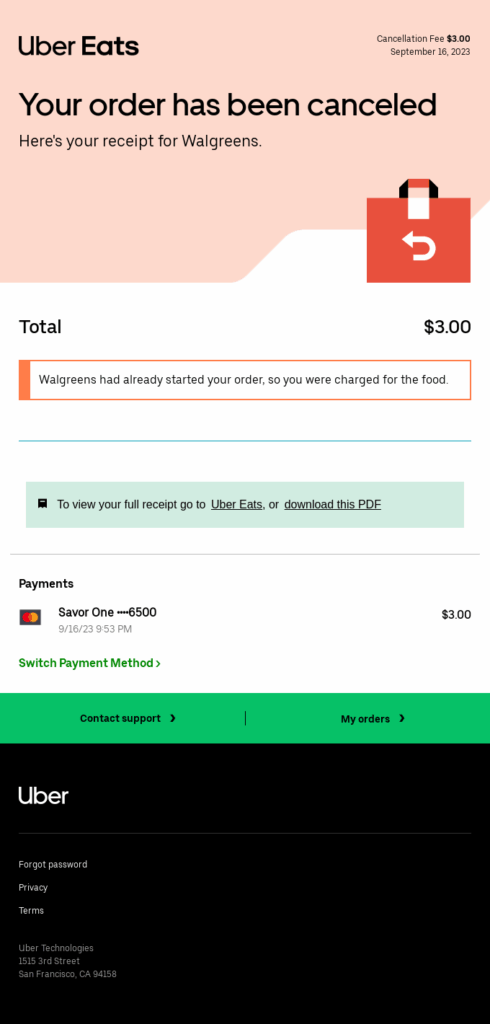
Has a customer cancelled an order? Inform them with a follow-up email that their action is complete like Uber.
Why it works:
- The subject line is descriptive so that readers immediately understand the purpose of this email.
- They clarified that the customer was charged for the food due to late cancellation to avoid confusion.
- They added the receipt and the payment method in case recipients want to double check the charge and feel confident about the transaction.
Revamp Your Order Confirmation Emails
Order confirmation emails are powerful assets for eCommerce store owners. When done right, they can elevate your customer service, build trust, and even drive more conversions.
Before setting them up, set clear goals, and keep track of key metrics to refine them if needed. Data will show you what to include to make your confirmational emails more functionable and memorable.
FAQs
Let’s explore some frequently asked questions regarding order confirmation emails:
1. What information should be included in an order confirmation email?
Order confirmation emails contain essential details about a customer’s purchase including the order status and number, total amount paid, payment method, shipping address, and next steps.
2. How can an order confirmation email boost customer satisfaction?
It reassures customers that their order has been successfully placed and confirms that all steps, like entering personal information and completing payment, have been finalized. Moreover, it shows what’s coming next, to manage expectations.
3. What makes a good order confirmation email?
Good order confirmation emails have a clear structure, important details about the customer’s order, such as the amount paid, personal information, customer support details, and a few design elements that showcase the brand’s identity.
4. How do you send an order confirmation email?
You can set up automated order confirmation emails using email services such as Moosend that support that feature. Alternatively, you can configure them manually using an SMTP server, giving you more control over the sending process.

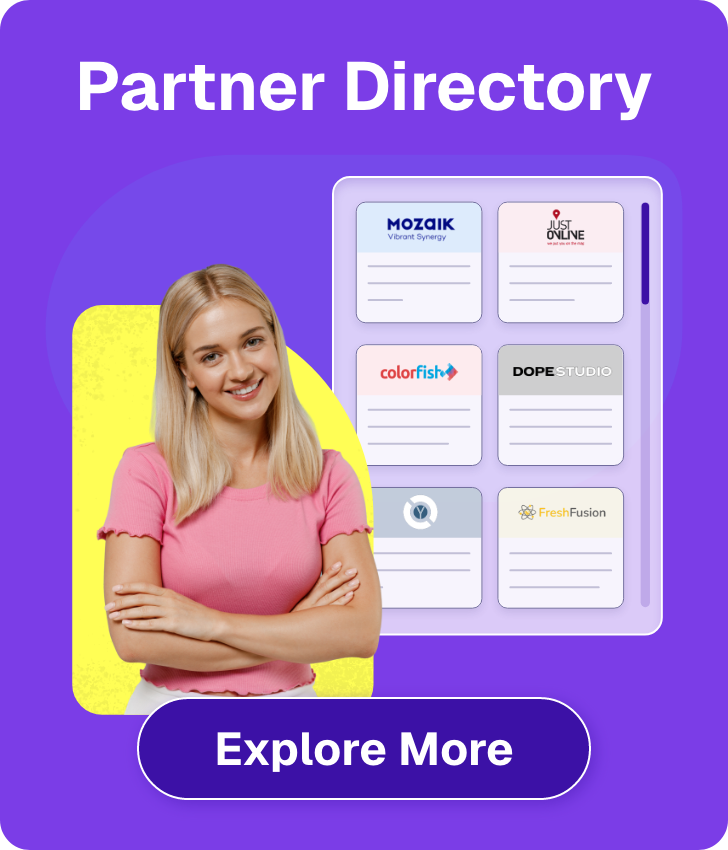

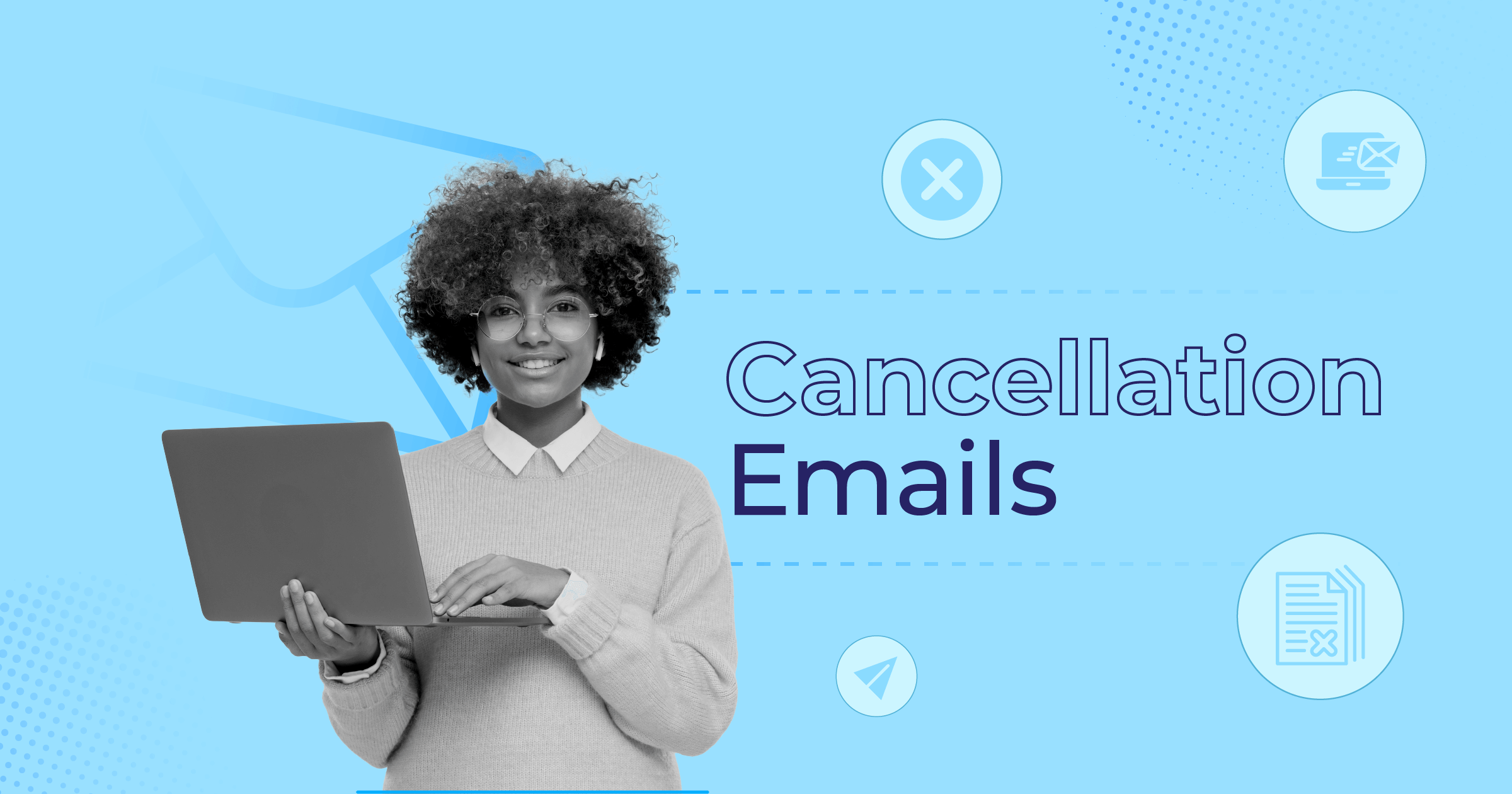
 Published by
Published by
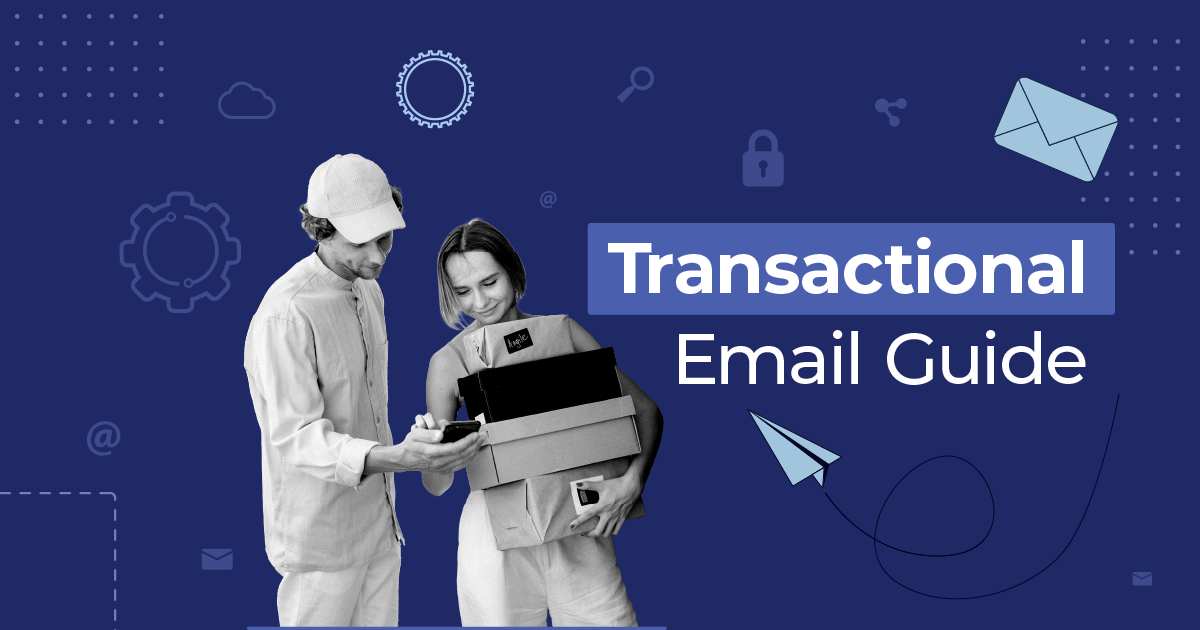

 Published by
Published by